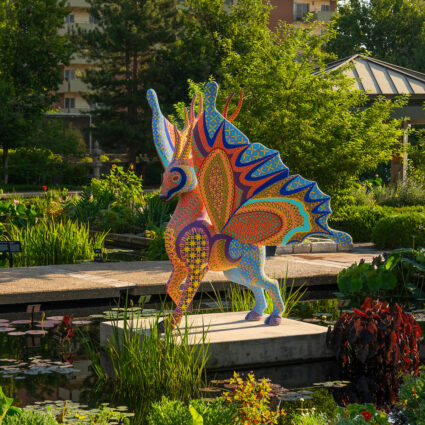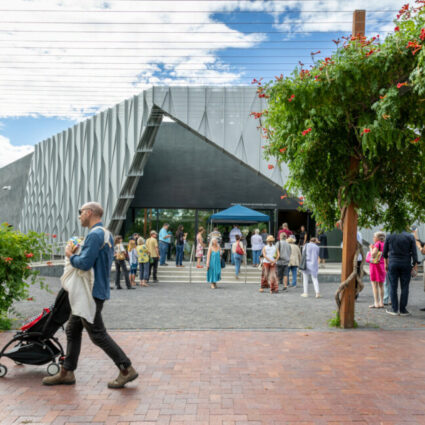Artists and poets from Tohono O’odham Nation, a tribe divided by the U.S.-Mexico border, join with myriad voices to counter borderland crisis narratives at University of Arizona.

TUCSON, AZ—Countering crisis narratives centered on the U.S.-Mexico border, a multidisciplinary arts collective is exploring the realities of the Southwest borderlands through photography, poetry, and community participation—including collaborations with Tohono O’odham leaders, artists, and poets whose ancestral lands are bisected by the border.
Their work is featured in a collaborative multilingual exhibition, ‘Amai Mo ‘Am Ṣo:ṣon G Cewagĭ / El lugar donde se forman las nubes / The Place Where Clouds Are Formed, on view at the Center for Creative Photography and the Poetry Center at the University of Arizona in Tucson through August 31, 2024.
The exhibition, which includes more than forty photographs and over twenty poems, is the latest iteration of an ongoing project launched in 2018 by Arizona-based linguist and poet Ofelia Zepeda (Tohono O’odham), New York-based photographer Gareth Smit, and Belgium-based historian and writer Martín Zícari.
“We really wanted to think about how photography can take on bigger issues without perpetuating images of violence, but also how to bring a more poetic approach and create spaces for people to reflect on these issues,” Smit recalls of early conversations with Zícari, which led them to Zepeda and her work.
The trio titled both their collective and ongoing project The Place Where Clouds Are Formed, echoing a 2008 poem by Zepeda that prompts reflection of the liminal nature of life in this region that’s home to the Tohono O’odham Nation, which is one of twenty-two federally-recognized tribes in Arizona.

The project places photographs taken in Sonora, Mexico, and Southern Arizona in conversation with poetry written and recorded in O’odham and English and translated into Spanish, reflecting the collective’s goal of exploring the intersections of migration and spirituality in the Sonoran Desert, where historical and contemporary power structures have significant impacts on those who live and migrate in the region.
Policies and actions of the U.S. government, from mid-19th century treaties setting U.S.-Mexico boundaries to recent efforts to build additional sections of the border wall, for example, have divided and clustered the Tohono O’odham people while separating them from sacred sites and ancestral homelands. Meanwhile, their lands are a major point of passage for migrants.
The collective worked with traditional Tohono O’odham leaders as part of its creative process, and the current exhibition spanning two sites at the University of Arizona features works by several Tohono O’odham artists, including Amber Lee Ortega (Hia Ced O’odham and Tohono O’odham), a Tucson-based spoken word poet and photographer whose history of activism includes protesting construction of the border wall.
“I hope the exhibit will help people understand the loss that is felt by Indigenous people and bring our suffering to the surface,” says Ortega, who imbues her work with Tohono O’odham history and culture. “I love this project because it incorporates the language that we were deprived of using to tell our stories as a tool for sharing them now, and because it encompasses more than one story.”
The exhibition, which expands the project’s breadth and depth by examining the significance of collaboration itself and including works by new collaborators exploring migration and identity, was curated by Denisse Brito, Jenna S. Green, and Julie Swarstad Johnson—with guidance from the collective’s co-founders.

Mónica Martínez-Díaz, a visual artist born in Juarez, Mexico who lives and works in San Antonio, Texas, is showing a triptych of digital collages printed on silk that reflects her own migrant experiences, as well as those of her family, for this exhibition. “I wanted to add another voice to the project, as someone who knows what it’s like to cross the border every day. I wanted to counter the stereotypes about the borderlands, which is a complex ecosystem with a lot of nuance and grey areas,” Martínez-Díaz says.
Other collaborators featured in the current exhibition include Terrol Dew Johnson (Tohono O’odham), Chris Lasch, Alice Wilsey, and Su:k Chu:vak Fulwilder (Onk Akimel O’odham, Xalchidom Piipaash, Tlingit, Aleut and Pomo).
Clearly, there’s more to the project than the tangible artworks in this show.
“I feel like the core of this project is really community building, says Martínez-Díaz, who describes the founding trio as “true community builders.” As an example, she cites the collective’s thoughtful work with artists and their practice of arranging transportation for people who couldn’t otherwise see the work.
Currently, the project is part of Fronteridades: Nurturing Collaborative Intersections in the U.S.-Mexico Border, a larger effort at the University of Arizona that also seeks to diversify perspectives and counter stereotypes in the Southwest borderlands.
Six years into their collaboration, Smit says the trio is thinking about ways to reach larger audiences with The Place Where Clouds Are Formed, perhaps by publishing a book or creating a dedicated website, even as they focus on the current show in Tucson. “Exhibitions,” he says, “can be good places to start broader conversations.”






